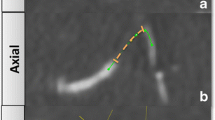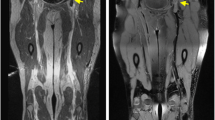Abstract
Intravascular thrombosis and thromboembolism are critical diagnoses which are frequently made on contrast-enhanced computed tomography (CECT) or Doppler ultrasound. For a variety of reasons, some patients with acute intravascular pathology are imaged using CT without intravenous contrast. In the acute setting, the increased Hounsfield unit (HU) density of the thrombus compared to the blood pool allows the diagnosis to be made, or at least suggested, on non-enhanced computed tomography (NECT). The increased density of the clot is commonly referred to as the “hyperdense vessel sign.” This is a well-known finding in the setting of stroke, but hyperdense vessels can also signal arterial or venous thrombosis in the chest, abdomen, pelvis, and extremities. Once a hyperdense vessel sign is noted on NECT, further exploration with CECT, angiography, or ultrasound may then be performed. Here, we present a pictorial review of the appearance of acute intravascular thrombosis as seen on non-enhanced computed tomography.










Similar content being viewed by others
References
Previtali E, Bucciarelli P, Passamonti SM, Martinelli I (2011) Risk factors for venous and arterial thrombosis. Blood Transfus 9:120–138
Norman D, Price D, Boyd D, Fishman R, Newton TH (1977) Quantitative aspects of computed tomography of the blood and cerebrospinal fluid. Radiology 123:335–338
New PFJ, Aronow S (1976) Attenuation measurements of whole blood and blood fractions in computed tomography. Radiology 121:635–640
Morita S, Ueno E, Masukawa A, Suzuki K, Machida H, Fujimura M (2010) Hyperattenuating signs at unenhanced CT indicating acute vascular disease. RadioGraphics 30:111–125
Swenson SJ, McLeod RA, Stephens DH (1984) CT of extracranial hemorrhage and hematomas. AJR Am J Roentgenol 143:907–912
Petitti N (1998) The hyperdense middle cerebral artery sign. Radiology 208(3):687–688
Jensen UR, Weiss M, Zimmerman P, Jansen O, Riedel C (2010) The hyperdense anterior cerebral artery sign (HACAS) as a computed tomography marker for acute ischemia in the anterior cerebral artery territory. Cerebrovasc Dis 29:62–67
Connell L, Koerte IK, Laubender RP et al (2012) Hyperdense basilar artery sign—a reliable sign of basilar artery occlusion. Neuroradiology 54:321–327
Ozdemir O, Leung A, Bussiere M, Hachinski V, Pelz D (2008) Hyperdense internal carotid artery sign: a CT sign of acute ischemia. Stroke 39:2011–2016
Krings T, Noelchen D, Mull M et al (2006) The hyperdense posterior cerebral artery sign: a computed tomography marker of acute ischemia in the posterior cerebral artery territory. Stroke 37:399–403
Gotway MB, Webb WR (2000) Acute pulmonary embolism: visualization of high attenuation clot in the pulmonary artery on non-contrast helical chest CT. Emerg Radiol 7:117–119
Kanne JP, Gotway MB, Thuoongsuwan S, Stern EJ (2003) Six cases of acute central pulmonary embolism revealed on unenhanced multi-detector CT of the chest. AJR Am J Roentgenol 180:1661–1664
Cobelli R, Zompatori M, De Luca G, Chiari G, Bresciani P, Marcato C (2005) Clinical usefulness of computed tomography study without contrast injection in the evaluation of acute pulmonary embolism. J Comput Assist Tomogr 29:6–12
Castaner E, Andreu M, Gallardo X, Mata JM, Cabezuelo MA, Pallardo Y (2003) CT in nontraumatic acute thoracic aortic disease: typical and atypical features and complications. RadioGraphics 23:S93–S110
Gonsalves CF (1999) The hyperattenuating crescent sign. Radiology 211:37–38
Augustinos P, Ouriel K (2004) Invasive treatment of venous thromboembolism. Circulation 110:I-27–I-34
McRae SJ, Ginsberg JS (2004) Initial treatment of venous thromboembolism. Circulation 110:I-3–I-9
Ouriel K, Veith FJ, Sasahara AA (1998) A comparison of recombinant urokinase with vascular surgery as initial treatment for acute arterial occlusion of the legs. N Engl J Med 338:1105–1111
Leach JL, Fortuna RB, Jones BV, Gaskill-Shipley MF (2006) Imaging of cerebral venous thrombosis: current techniques, spectrum of findings, and diagnostic pitfalls. RadioGraphics 26:S19–S43
Cortez O, Schaeffer CJ, Hatem SF, Glauser J, Ahmed M (2009) Cases from the Cleveland clinic: cerebral venous sinus thrombosis presenting to the emergency department with worst headache of life. Emerg Radiol 16:79–82
Puig J, Pedraza S, Demchuk A et al (2012) Quantification of thrombus Hounsfield units on noncontrast CT predicts stroke subtype and early recanalization after intravenous recombinant tissue plasminogen activator. AJNR Am J Neuroradiol 33:90–96
Lee TC, Bartlett ES, Fox AJ, Symons SP (2005) The hypodense artery sign. AJNR Am J Neuroradiol 26:2027–2029
Lovy AJ, Rosenblum JK, Levsky JM et al (2013) Acute aortic syndromes: a second look at dual-phase CT. AJR Am J Roentgenol 200(4):805–811
White RH (2003) The epidemiology of venous thromboembolism. Circulation 107:I-4–I-8
Luciani A, Clement O, Halimi P et al (2001) Catheter-related upper extremity deep venous thrombosis in cancer patients: a prospective study based on doppler ultrasound. Radiology 220:655–660
Ellis MH, Manor Y, Witz M (2000) Risk factors and management of patients with upper extremity deep vein thrombosis. Chest 117:43–46
Prandoni P, Polistena P, Bernardi E et al (1997) Upper-extremity deep vein thrombosis: risk factors, diagnosis, and complications. Arch Intern Med 157(1):57–62
Rucker CM, Menias CO, Bhalla S (2004) Mimics of renal colic: alternative diagnoses at unenhanced helical CT. RadioGraphics 24:S11–S33
Okino Y, Kiyosue H, Mori H et al (2001) Root of the small bowel mesentery: correlative CT anatomy and CT features of pathologic conditions. RadioGraphics 21:1475–1490
Warshauer DM, Lee JKT, Mauro MA, White GC (2001) Superior mesenteric vein thrombosis with radiologically occult cause: a retrospective study of 43 cases. AJR Am J Roentgenol 177:837–841
Girard P, Hauuy MP, Musset D, Simonneau G, Petitpretz P (1989) Acute inferior vena cava thrombosis: early results of heparin therapy. Chest 95:284–291
Ferris EJ, McCowan TC, Carver DK, McFarland DR (1993) Percutaneous inferior vena caval filters: follow-up of seven designs in 320 patients. Radiology 188(3):851–856
Akpinar E, Turkbey B, Eldem G, Karcaaltincaba M, Akhan O (2009) When do we need contrast-enhanced CT in patients with vague urinary system findings on unenhanced CT? Emerg Radiol 16(2):97–103
Gallego C, Velasco M, Marcuello P, Tejedor D, De Campo L, Friera A (2002) Congenital and acquired anomalies of the portal venous system. RadioGraphics 22:141–159
Zuckerman J, Levine D, McNicholas MMJ et al (1997) Imaging of pelvic postpartum complications. AJR Am J Roentgenol 168:663–668
Batra P, Bigoni B, Manning J et al (2000) Pitfalls in the diagnosis of thoracic aortic dissection on CT angiography. RadioGraphics 20:309–320
Godwin JD, Breiman RS, Speckman JM (1982) Problems and pitfalls in the evaluation of thoracic aortic dissection by computed tomography. J Comput Assist Tomogr 6:750–756
Acknowledgments
The authors would like to thank Dr. Jeffrey A. Breall, Professor of Clinical Medicine and director of Interventional Cardiology at the Krannert Institute of Cardiology, Indiana University School of Medicine, for providing the cardiac catheter images seen in Fig. 4c, d.
Conflict of Interest
The authors declare that they have no conflict of interest.
Author information
Authors and Affiliations
Corresponding author
Rights and permissions
About this article
Cite this article
Whitesell, R.T., Steenburg, S.D. Imaging findings of acute intravascular thrombus on non-enhanced computed tomography. Emerg Radiol 21, 271–277 (2014). https://doi.org/10.1007/s10140-014-1210-8
Received:
Accepted:
Published:
Issue Date:
DOI: https://doi.org/10.1007/s10140-014-1210-8




